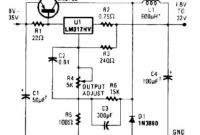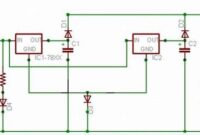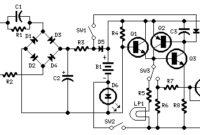Here the simple Mini UPS circuit diagram. This circuit can provide an uninterrupted power supply (UPS) to operate 12V, 9V and 5V DC-powered instruments at up to 1A current. The backup battery will take up the load with no spikes or delay when the mains electrical power gets interrupted. It could possibly also be utilized as a workbench power supply that delivers 12V, 9V and 5V operating voltages. The circuit instantly disconnects the load when the battery voltage decreases to 10.5V to avoid deep discharge of your battery. LED1 indication is presented to indicate the complete charge voltage level of the battery. Miniature white LEDs (LED2 and LED3) are utilized as emergency lamps especially during electrical power failure at night time.
A common step-down transformer delivers 12V of AC, that is rectified by diodes D1 and D2. Capacitor C1 features ripple-free DC to charge the battery and to the remaining circuit. When the mains electrical power is on, diode D3 gets forward biased to charge the battery. Resistor R1 limits the charging current. Potentiometer VR1 (10k) with transistor T1 acts as being the voltage comparator to indicate the voltage level. VR1 is so adjusted that LED1 is in the “off” mode. when the battery is completely charged, LED1 glows indicating a maximum voltage level of 12V.
When the mains power fails, diode D3 gets reverse biased and D4 gets forward biased so that the battery can automatically take up the load without any delay. When the battery voltage or input voltage falls below 10.5V, a cut-off circuit is used to prevent deep discharging of the battery. Resistor R3, zener diode ZD1 (10.5V) and transistor T2 form the cut-off circuit. When the voltage level is above 10.5V, transistor T2 conducts and its base becomes negative (as set by R3, VR2 and ZD1). But when the voltage reduces below 10.5V, the zener diode stops conduction and the base voltage of transistor T2 becomes positive. It goes into the “cut-off” mode and prevents the current in the output stage. Preset VR2 (22k) adjusts the voltage below 0.6V to make T2 work if the voltage is above 10.5V.
When power from the mains is available, all output voltages12V, 9V and 5Vare ready to run the load. On the other hand, when the mains power is down, output voltages can run the load only when the battery is fully charged (as indicated by LED1). For the partially charged battery, only 9V and 5V are available. Also, no output is available when the voltage goes below 10.5V. If battery voltage varies between 10.5V and 13V, output at terminal A may also vary between 10.5V and 12V, when the UPS system is in battery mode. Outputs at points B and C provide 9V and 5V, respectively, through regulator ICs (IC1 and IC2), while output A provides 12V through the zener diode. The emergency lamp uses two ultra-bright white LEDs (LED2 and LED3) with current limiting resistors R5 and R6. The lamp can be manually switched “on” and “off” by S1.
The mini UPS circuit is assembled on a general purpose PCB. There is adequate space between the components to avoid overlapping. heat sinks for transistor T2 and regulator ICs (7809 and 7805) to dissipate heat are used.
The positive and negative rails should be strong enough to handle high current. Before connecting the circuit to the battery and transformer, connect it to a variable power supply. Provide 12V DC and adjust VR1 till LED1 glows. After setting the high voltage level, reduce the voltage to 10.5V and adjust VR2 till the output trips off. After the settings are complete, remove the variable power supply and connect a fully-charged battery to the terminals and see that LED1 is on. After making all the adjustments connect the circuit to the battery and transformer. The battery used in the mini UPS circuit is a 12V, 4.5Ah UPS battery.





is anysomeone expirient more voltage for output ac 4000 to 5000wat by using these methode without using circuit only jumpering.
I want to make new powerful invert Ac
if the battery is over charged we need to power off the main. so please help me that, i want the battery to automatically charge and cut off. so please help me and add that automatic circuit to this circuit please please. if u add that this device is very much useful.
Hi, nice circuit with description, but it is not indicated whether it is online or offline ups.